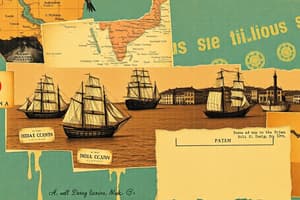Podcast
Questions and Answers
What was a major product traded along the Silk Road?
What was a major product traded along the Silk Road?
- Salt
- Ivory
- Gold
- Silk (correct)
Which city was NOT a significant trade hub on the Trans-Saharan Trade Routes?
Which city was NOT a significant trade hub on the Trans-Saharan Trade Routes?
- Cairo (correct)
- Marrakech
- Timbuktu
- Gao
What impact did the Indian Ocean Trade Network have on cultural diffusion?
What impact did the Indian Ocean Trade Network have on cultural diffusion?
- Spread of agricultural techniques
- Exchange of scientific tools
- Distribution of art and religion (correct)
- Sharing of military strategies
Which empire was known for its wealth in gold and significantly influenced West African trade?
Which empire was known for its wealth in gold and significantly influenced West African trade?
What was a major consequence of the rise of maritime powers in Europe during the late medieval period?
What was a major consequence of the rise of maritime powers in Europe during the late medieval period?
Which cultural exchange occurred along the trade routes of Afro-Eurasia?
Which cultural exchange occurred along the trade routes of Afro-Eurasia?
What challenge affected trade in the Afro-Eurasian trading world?
What challenge affected trade in the Afro-Eurasian trading world?
What effect did the Afro-Eurasian trading world have on urbanization?
What effect did the Afro-Eurasian trading world have on urbanization?
Flashcards are hidden until you start studying
Study Notes
Overview
- The Afro-Eurasian trading world encompasses regions of Africa, Europe, and Asia.
- It facilitated extensive trade networks and cultural exchanges from ancient times through the Middle Ages.
Key Trade Routes
-
Silk Road
- Connects East Asia (China) to the Mediterranean.
- Major goods: silk, spices, precious metals, and textiles.
- Cultural exchanges included ideas, religion, and technology.
-
Trans-Saharan Trade Routes
- Links West Africa to North Africa via the Sahara Desert.
- Key commodities: gold, salt, ivory, and slaves.
- Important cities: Timbuktu, Gao, and Marrakech as trade hubs.
-
Indian Ocean Trade Network
- Connects East Africa, the Middle East, India, and Southeast Asia.
- Major goods: spices, textiles, gems, and exotic animals.
- Cultural diffusion included art, religion, and languages.
Major Empires and States Involved
- Mali Empire: Center of West African trade, famous for wealth in gold.
- Ottoman Empire: Controlled key routes between Europe and Asia, impacting trade and culture.
- Ming Dynasty: Enhanced trade with the West through maritime expeditions and silk production.
- Venetian Republic: Key player in Mediterranean trade, connecting Europe to Asia.
Cultural and Economic Impact
- Spread of religions (Islam, Buddhism, Christianity) along trade routes.
- Flourishing of cities due to trade; urbanization increased.
- Knowledge exchange: scientific, mathematical, and philosophical advancements shared among cultures.
- Economic interdependence began to grow among regions.
Challenges and Changes
- Natural obstacles (deserts, mountains) and political instability affected trade.
- Plagues and pandemics (e.g., Black Death) disrupted trade flows and population.
- The rise of maritime powers in Europe shifted trade dynamics by the late medieval period.
Conclusion
- The Afro-Eurasian trading world was a complex, interconnected network that influenced economic, cultural, and political spheres across continents.
- It laid the groundwork for global trade practices and cultural exchanges that continue to evolve today.
The Afro-Eurasian Trading World
- Connects Africa, Europe, and Asia from ancient times through the Middle Ages
Key Trade Routes
- Silk Road: Connected East Asia (China) to the Mediterranean, traded silk, spices, precious metals, and textiles.
- Trans-Saharan Trade Routes: Linked West Africa to North Africa across the Sahara Desert, traded gold, salt, ivory, and slaves.
- Indian Ocean Trade Network: Connected East Africa, the Middle East, India, and Southeast Asia, traded spices, textiles, gems, and exotic animals.
Major Empires and States
- Mali Empire: Center of West African trade, known for its wealth in gold.
- Ottoman Empire: Controlled key routes between Europe and Asia, impacting trade and culture.
- Ming Dynasty: Expanded trade with the West through maritime expeditions and silk production.
- Venetian Republic: Key player in Mediterranean trade, connecting Europe to Asia.
Cultural and Economic Impacts
- Spread of religions (Islam, Buddhism, Christianity) along trade routes.
- Cities flourished due to trade, urbanization increased.
- Knowledge exchange: Scientific, mathematical, and philosophical advancements were shared among cultures.
- Economic interdependence grew among regions.
Challenges and Changes
- Natural obstacles (deserts, mountains) and political instability affected trade.
- Plagues and pandemics (e.g., Black Death) disrupted trade flows and population.
- The rise of maritime powers in Europe shifted trade dynamics by the late medieval period.
Conclusion
- The Afro-Eurasian trading world was a complex and interconnected network that influenced economic, cultural, and political spheres across continents.
- It laid the groundwork for global trade practices and cultural exchanges that continue to evolve today.
Studying That Suits You
Use AI to generate personalized quizzes and flashcards to suit your learning preferences.




